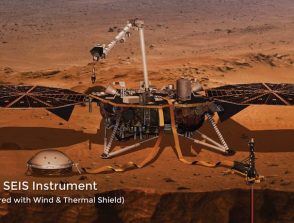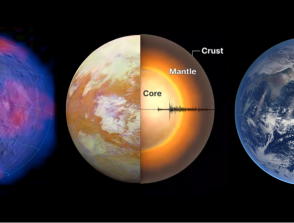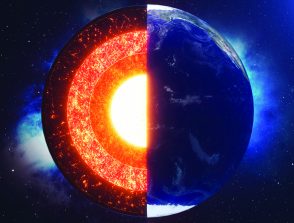Mars Geophysical InSight (MAGIS) ANR
Start: 01/09/2019 - End: 29/02/2024
National partnership
Coordinators : Philippe Lognonné
Host institutions :
Institut de Physique du Globe de Paris
Partner institutions :
LANL, ISAE-Supaero, JPL, LPG, Lagrange, IMPMC, LGL-TPE, IRAP, LMD
Related observatories :
InSight Observatory
Related teams :
Planetology and Space Sciences
Related themes :
Earth and Planetary Interiors
The InSight mission (Interior Exploration Using Seismic Investigations, Geodesy, and Heat Transport) landed successfully on Mars on November 26, 2018. Although the deployment of one of the InSight Instrument (HP3) could not be achieved, the two instruments on which MAGIS focus (SEIS and APSS) have been fully operational and proved performances much better than the mission requirements.
InSight will illuminate the fundamental processes of terrestrial-planet formation and evolution by performing the first comprehensive surface-based geophysical investigation of Mars. It will provide key information on the composition and structure of an Earth-like planet that has gone through most of the evolutionary stages of the Earth up to, but not including, plate tectonics. Thus, the clues of early history of terrestrial planet formation are still contained in the basic parameters of Mars: core’s size, state and composition, composition and layering of the mantle, crust thickness and layering and internal heat flux.
InSight is the first mission ever sent to an extra-terrestrial body (Mars) to enable the breakthroughs obtained on Earth after the 1889 first quake observation made by von Reuber-Pacshwitz which leads to the discovery of the Moho and core mantle boundary respectively by Mohorovičić, in 1910 and Oldham, in 1906. InSight is also the first NASA Discovery mission with a primary French-led PI Instrument and has therefore a strong French implication, with 10 co-investigators associated to the mission, all contributing to this proposal together with their teams.
Because of the quasi-absence of knowledge on Mars’ seismology and surface geophysics, the science objectives of MAGIS are broad and very fundamental, addressing overarching questions of Planetary Science and Geophysics by r transdisciplinary research approaches. The ANR MAGIS did therefore not only covered the science explored by the Very-Broad-Band (VBB) seismometer of SEIS, but also those made possible by joint VBB-APSS analysis. The SEIS VBB sensors are so sensitive they will detect the large quakes enabling the access to the deep internal structure of Mars, the smaller quakes related to tectonic activity and impacts on the Martian surface, and the ground deformations and micro-seismic noise associated with atmospheric activities, from global-scale circulations to turbulence and infrasounds in the Atmospheric Boundary Layer.
The members of the MAGIS team all bring a specific expertise in each of those scientific topics and play a central role in the related operational services set up in the InSight mission, respectively the Mars Structure Service (MSS), the Mars Quake Service (MQS), and the Mars Weather Service (MWS). Accordingly, MAGIS scientific goals are related to Mars interior imaging, Mars mineralogy and evolution, Mars seismo-tectonic and impacts processes and atmosphere/interior seismic coupling and Mars’ atmospheric dynamics. In parallel, and because of the expected challenge in the data analysis, MAGIS aimed also to develop specific and innovative data processing algorithm to extract the seismic information from the InSight data, including with machine learning.
All the MAGIS effort has led to revolutionize our understanding of Mars Interior, with more than 50 papers published by the project.







